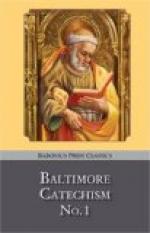The Pope dresses in white, the cardinals in red, the bishops in purple, and the priests and other ministers in black. A “Monsignor” is also a title of dignity granted by our Holy Father to some worthy priests. It gives them certain privileges, and the right to wear purple like a bishop. The “Vicar General” is one who is appointed by the bishop in the diocese, and shares his power. In the bishop’s absence he acts as bishop in all temporal and worldly matters and also in some spiritual things, concerning the diocese. A diocese is the extent of country over which a bishop is appointed to rule, as a parish is the extent over which a pastor is appointed to administer the Sacraments and rule under the direction of the bishop. Pastors are also called rectors. Pastor means a shepherd, and rector means a ruler; and as all pastors rule their flocks, pastor and rector mean about the same.
An archbishop is higher than a bishop, though he has no more spiritual power than a bishop. The district over which an archbishop rules contains several dioceses with their bishops, and is called an ecclesiastical province. The bishops in the province are called suffragan bishops, because subject in some things to the authority of the archbishop, who is also called the metropolitan, because bishop of a metropolis or chief city of the province over which he presides.
The archbishop can wear the pallium, a garment worn by the Pope, and sent by him to patriarchs, primates, and archbishops. It is a band of white wool, worn over the shoulders and around the neck after the manner of a stole. It has two strings of the same material and four black or purple crosses worked upon it. It is the symbol of the plenitude of pastoral jurisdiction conferred by the Holy See. Morally speaking, it reminds the wearer how the good shepherd seeks the lost sheep and brings it home upon his shoulders, and how the loving pastor of souls should seek those spiritually lost and bring them back to the Church, the true fold of Christ.
282 Q. What is the Sacrament of Matrimony? A. The Sacrament of Matrimony is the Sacrament which unites a Christian man and woman in lawful marriage.
“Christian,” because if they are not Christians they do not receive the grace of the Sacrament.
283 Q. Can a Christian man and woman be united in lawful marriage in any other way than by the Sacrament of Matrimony? A. A Christian man and woman cannot be united in lawful marriage in any other way than by the Sacrament of Matrimony, because Christ raised marriage to the dignity of a Sacrament.
“Lawful.” Persons are lawfully married when they comply with all the laws of God and of the Church relating to marriage. To marry unlawfully is a mortal sin, in which the persons must remain till the sin is forgiven. “Sacrament.” Before the coming of Our Lord persons were married as they are now, and even lawfully according to the laws of the Old Testament or old religion; but marriage did not give them any grace. Now it does give grace, because it is a Sacrament, and has been so since the time of Our Lord. Before His coming it was only a contract, and when He added grace to the contract it became a Sacrament.




